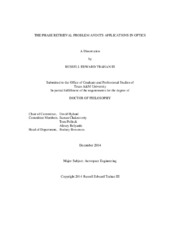| dc.description.abstract | In this dissertation the various forms and applications of the phase retrieval problem in imaging are discussed. The phase retrieval problem in general refers to the estimation of the phase of a complex-valued function based on knowledge of its magnitude. Here the phase retrieval problem is applied to the estimation of the phase of an electromagnetic wave field based on knowledge of its magnitude. The magnitude (not the phase) can be measured using several devices as discussed.
There are many applications of phase retrieval which have been explored where the mapping between the detected wave field magnitude and the light source is the Fourier transform. Within these applications phase retrieval solutions are used to estimate the phase of the Fourier transform so as to obtain the image or the shape of the light emitter. These solutions necessitate a model of the propagation of the wave field, a method of detecting the field’s magnitude, and a method of estimating the phase of the observed field. The first two considerations are discussed here historically and reference many significant scientific discoveries, namely the Huygens-Fresnel principle, the Van Cittert-Zernike theorem, and the Michelson interferometer.
Within the field of interferometry where the Fourier transform is the mapping between the light source and observed wave field, most solutions utilize a discrete Fourier transform. The estimate of the light source takes the form of a two-dimensional pixelated image. These solutions have been explored for many years and have many variations for particular applications. Not many of these solution methods, however, have confronted the problem of measurement noise. Measurement noise here refers to noise in the quantification of the magnitude of the wave field at the observed locations. Within this dissertation the negative effects of noise are analyzed and a method of filtering the noise from the data is derived, tested, and shown to be effective. In a separate analysis the use of the discrete Fourier transform as opposed to the continuous Fourier transform is questioned. A phase solution is proposed which is capable of estimating the source of the observed wave field and takes discrete magnitude data and outputs a continuous image function formed from Gaussian bases. This method is beneficial from an analytical point-of-view since it is not an iterative solution. It also has an error metric which definitively determines whether the true solution has been found—unlike the traditional solution methods.
The phase retrieval problem is also explored in the case where the Fourier transform is not the mapping between the image and the observed wave field. Particularly, the case of a small asteroid occulting a star is analyzed with the goal of characterizing the shape of the asteroid’s silhouette. A solution is formulated capable of resolving the asteroid silhouette based on time histories of the intensity of the wave field measured at multiple spatial locations. The solution is based on an analysis of the shadow that the occulter casts.
The phase retrieval problem is present in many current fields of imaging and remains a prominent source of inquiry. Although many solution methods exist, there are still many improvements that can be made. This dissertation addresses some potential improvements to existing solutions and proposes new applications and formulations of the phase retrieval problem. | en |


